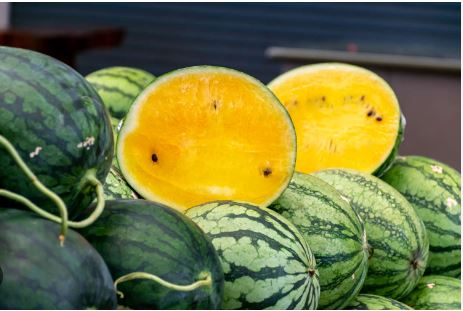
Yellow watermelon is just the same as any other watermelon other than its bright yellow flesh, which can range from pale yellow to a deep golden hue. This color comes from different pigments, mainly carotenoids like beta-carotene, rather than lycopene which gives red watermelons their color. The outside rind can vary, but it’s typically green with stripes, similar to red watermelons. Some varieties might have unique patterns or colors on the rind. In other words, Yellow watermelon is actually a natural variety of watermelon that has experienced a genetic mutation in which it does not produce any (or very low levels of) lycopene.
Yellow watermelons often have a sweeter, sometimes honey-like flavor compared to their red counterparts. Some describe the taste as having a slight floral or musky undertone, distinct from the watermelon flavor. The flesh can be crisp and juicy, though some varieties might have a denser, almost creamy texture, which is why some are named “Buttercup” or similar. Yellow watermelon is a summer fruit.
General Characteristics of Yellow Flesh Watermelons
Nutritional Profile
- Beta-Carotene: Yellow flesh often indicates higher levels of beta-carotene, which is beneficial for eye health and has antioxidant properties.
- Vitamins and Minerals: Like red watermelons, they are rich in vitamins A and C, but the yellow varieties might offer different nutrient profiles due to their unique pigments.
Cultivation
- Growing Conditions: Similar to other watermelons, they require warm temperatures, plenty of sun, and well-drained soil. However, they might have slightly different ripening indicators. Look for the tendril near the fruit stem to dry out or for the ground spot to turn yellow.
- Ripening: The flesh color doesn’t change as it ripens, unlike red watermelons, so other signs like the sound when thumped (a dull sound indicates ripeness) or the feel of the rind (should be slightly rough) are used.
Varieties of Yellow Flesh Watermelons
Yellow Doll
- Appearance: This seedless variety has a bright yellow flesh that contrasts beautifully with its green rind. The rind itself might have stripes or be solid green.
- Flavor: Known for its sweet, honey-like flavor, often described as having a richer, more concentrated taste than red watermelons. Some find it reminiscent of honeydew melon.
- Texture: The flesh is typically firm yet juicy, offering a crisp bite.
- Size: Generally smaller, making it perfect for personal or small family servings.
- Usage: Ideal for fresh eating, salads, smoothies, or even in desserts where its color can be a visual highlight.
Buttercup
- Appearance: Features a bright, almost neon-like yellow flesh. The rind can vary but often has a light green color with stripes.
- Flavor: Sweet with a creamy, almost buttery finish, which gives it its name. Some describe it as having a slight floral note.
- Texture: Slightly denser than typical watermelons, which adds to its unique mouthfeel.
- Size: Medium to large, offering versatility in use.
- Usage: Great for juicing due to its vibrant color, but also excellent in fruit salads or as a standalone snack.
Moon and Stars (Yellow Flesh Variant)
- Appearance: Famous for its unique rind pattern (yellow spots on a dark green background), some varieties have yellow flesh instead of the usual red.
- Flavor: The yellow-fleshed Moon and Stars often have a sweet, aromatic flavor with hints of floral or even slightly musky undertones.
- Texture: Can be quite juicy but with a firm texture, similar to other watermelons.
- Size: Can grow quite large, making it a statement piece in gardens or at markets.
- Usage: While often used decoratively, its flavor makes it suitable for consumption in various forms, from fresh slices to being part of fruit arrangements.
Culinary Uses
- Fresh Eating: The most straightforward way to enjoy yellow watermelon is fresh, either as slices or cubes, often appreciated for its unique flavor and color.
- Salads: Adds a sweet, vibrant element to fruit salads or can be paired with savory ingredients like feta cheese and mint for a contrasting flavor profile.
- Smoothies and Juices: The bright color makes for visually appealing drinks, and the sweetness can be a natural sweetener.
- Desserts: Used in sorbets, ice creams, or as a base for fruit-based desserts where its color and flavor can be highlighted.
- Garnishes: Its vibrant color makes it a popular choice for garnishing dishes or cocktails.